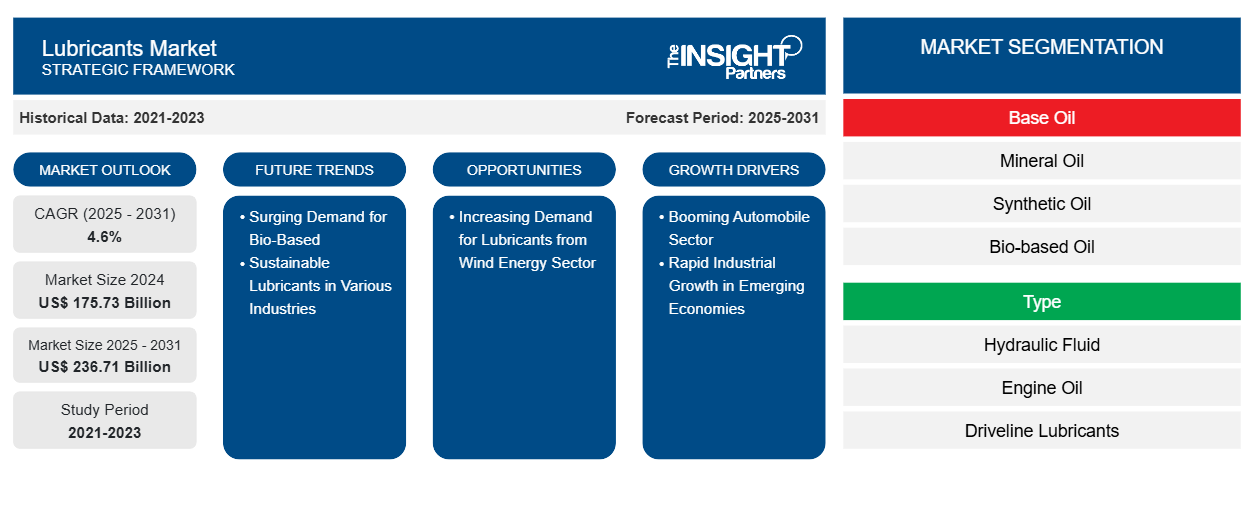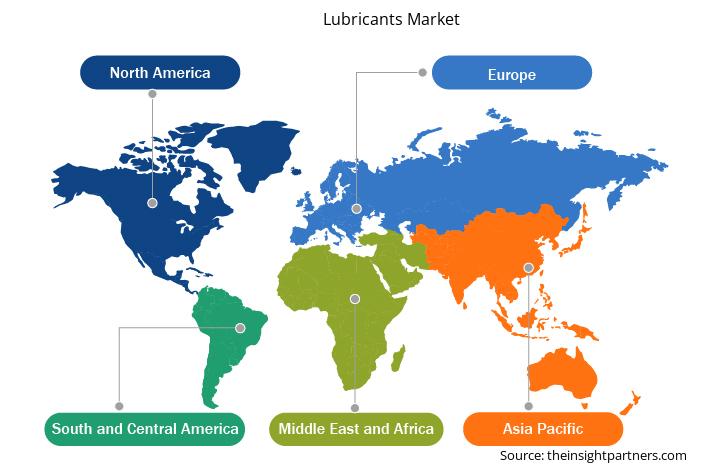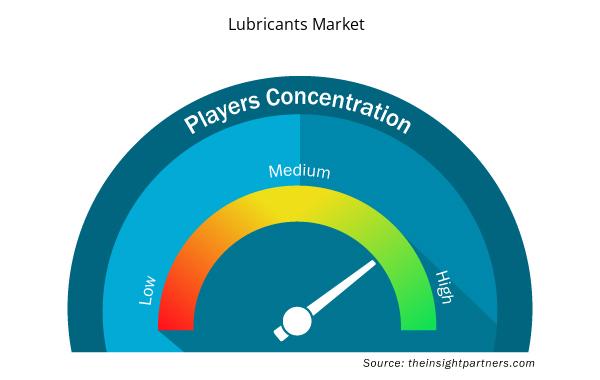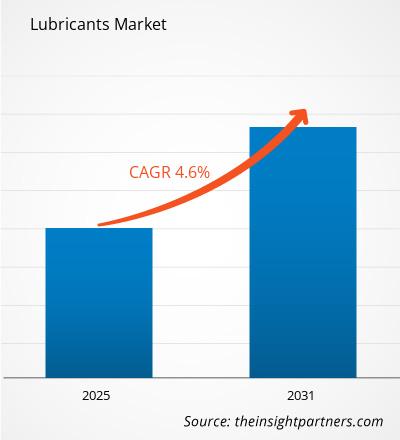Der Schmierstoffmarkt soll von 175,73 Milliarden US-Dollar im Jahr 2024 auf 236,71 Milliarden US-Dollar im Jahr 2031 anwachsen; für den Zeitraum 2025–2031 wird eine durchschnittliche jährliche Wachstumsrate (CAGR) von 4,6 % erwartet. Die steigende Nachfrage nach biobasierten und nachhaltigen Schmierstoffen in verschiedenen Branchen dürfte ein wichtiger Markttrend sein.
Schmierstoffmarktanalyse
Weltweit investieren Hersteller in die Verbesserung ihrer Lieferkette, um den Autoabsatz in Entwicklungsregionen zu steigern. Laut der Society of Indian Automobile Manufacturers (SIAM) stiegen in Indien die Pkw-Verkäufe von ~2.409.535 Einheiten im November 2022 auf fast 2.854.242 Einheiten im November 2023. Die südafrikanische Automobilindustrie ist hinsichtlich der Anzahl der produzierten Fahrzeuge die 22.-größte der Welt und die größte auf dem afrikanischen Kontinent. Auf sie entfielen 2023 mehr als ~54 % der auf dem Kontinent montierten Fahrzeuge. Laut der Internationalen Organisation der Kraftfahrzeughersteller (OICA) war Brasilien 2023 der größte Hersteller und Exporteur von leichten und Nutzfahrzeugen in Süd- und Mittelamerika. Das Land meldete im Jahr 2022 eine Produktion von fast 2,3 Millionen Fahrzeugen. Schmierstoffe sind in Fahrzeugen mit Verbrennungsmotor (ICE) traditionell unverzichtbar, da sie die Reibung verringern, Verschleiß verhindern und helfen, die Motorwärme zu regulieren. Der Aufstieg der Elektrofahrzeuge hat jedoch eine neue Dynamik auf den Schmierstoffmarkt gebracht . Obwohl Elektrofahrzeuge keine herkömmlichen Motoren besitzen, sind sie dennoch auf Schmierstoffe in verschiedenen Komponenten wie Getrieben, Motoren und anderen Antriebsstrangteilen angewiesen. Die wachsende Automobilindustrie beschleunigt daher die Nachfrage nach Schmierstoffen und trägt so zu einer besseren Fahrzeugleistung und Langlebigkeit bei.
Marktübersicht für Schmierstoffe
Weltweit befinden sich zahlreiche Länder in einer Industrialisierung, die zu einem Anstieg des Maschinen- und Anlageneinsatzes in verschiedenen Sektoren führt. Branchen wie Fertigung, Bauwesen, Bergbau und Landwirtschaft sind stark auf Maschinen angewiesen, die Schmierstoffe für optimale Leistung und Langlebigkeit benötigen. Die zunehmende Industrieaktivität und das Wachstum der Bau- und Landwirtschaftsindustrie dürften die Nachfrage nach Schmierstoffen erhöhen.
Passen Sie diesen Bericht Ihren Anforderungen an
Sie erhalten kostenlos Anpassungen an jedem Bericht, einschließlich Teilen dieses Berichts oder einer Analyse auf Länderebene, eines Excel-Datenpakets sowie tolle Angebote und Rabatte für Start-ups und Universitäten
Schmierstoffmarkt:

- Informieren Sie sich über die wichtigsten Markttrends in diesem Bericht.Dieses KOSTENLOSE Beispiel umfasst eine Datenanalyse, die von Markttrends bis hin zu Schätzungen und Prognosen reicht.
Treiber und Chancen des Schmierstoffmarktes
Schnelles industrielles Wachstum in Schwellenländern treibt Marktwachstum an
Verschiedene Schmierstoffarten wie mineralische und synthetische Schmierstoffe, Fette, Kompressorenöle und Schneidflüssigkeiten werden in der Öl- und Gasindustrie, der Textilindustrie, im Bergbau und in der Metallurgie, der Energieerzeugung, der Papier- und Zellstoffindustrie, der Chemie- und Petrochemieindustrie, der Landwirtschaft, der Fertigung, der Lebensmittel- und Getränkeindustrie sowie der Pharmaindustrie eingesetzt. Laut den im November 2024 von Trading Economics veröffentlichten Daten stieg die Industrieproduktion in China um 5,4 %. Da der Bergbausektor ein starkes Wachstum verzeichnet, steigt auch der Bedarf an Schmierstoffen, vor allem aufgrund des umfangreichen Einsatzes schwerer Maschinen im Bergbau. Diese Maschinen, die für die Gewinnung und Verarbeitung von Mineralien unerlässlich sind, benötigen eine effiziente Schmierung, um einen reibungslosen Betrieb zu gewährleisten, Verschleiß zu reduzieren und die Lebensdauer zu verlängern. Bergbauaktivitäten, die durch raue Betriebsbedingungen gekennzeichnet sind, belasten die Gerätekomponenten erheblich. Schmierstoffe sind entscheidend, um Reibung zu mindern, Temperaturen zu regulieren und Korrosion zu verhindern und so die Gesamtleistung und Langlebigkeit von Bergbaumaschinen zu verbessern. Angesichts der wachsenden Nachfrage nach Mineralien und Metallen, die den Bergbau antreibt, erlebt der Schmierstoffmarkt einen entsprechenden Aufschwung, da Bergbauunternehmen der Wartung und Optimierung ihrer Ausrüstung höchste Priorität einräumen.
Steigende Nachfrage nach Schmierstoffen aus der Windenergiebranche schafft Wachstumschancen auf dem Markt
Windenergie gehört zu den am schnellsten wachsenden Technologien für erneuerbare Energien und hat das Potenzial, einen großen Anteil am Schmierstoffverbrauch in der Energiebranche zu haben. Laut den von WindEurope veröffentlichten Daten wurden in Europa im Jahr 2023 18,3 GW neue Windkraftkapazität installiert, und zwischen 2024 und 2030 werden voraussichtlich weitere 260 GW neue Windkraftkapazität installiert. Da mehrere Länder in der Region auf erneuerbare Energiequellen, insbesondere Windkraft, setzen, ist der Bedarf an speziellen Schmierstoffen für den reibungslosen Betrieb der Windturbinen von größter Bedeutung. Diese Schmierstoffe verbessern die Betriebseffizienz und Lebensdauer der komplexen Maschinen, die zur Nutzung der Windenergie eingesetzt werden. Der wachsende Windenergiesektor benötigt eine zuverlässige und konstante Versorgung mit Hochleistungsschmierstoffen, um Verschleiß zu mindern, Reibung zu reduzieren und Korrosion in den mechanischen Komponenten von Windturbinen zu verhindern. Diese Nachfrage eröffnet Möglichkeiten für Forschung und Entwicklung und fördert Innovationen bei Schmierstoffformulierungen, die auf die besonderen Herausforderungen der Windenergieumgebung zugeschnitten sind.
Segmentierungsanalyse des Schmierstoffmarktberichts
Wichtige Segmente, die zur Ableitung der Schmierstoffmarktanalyse beigetragen haben, sind Grundöl, Typ und Endverbrauchsindustrie.
- Basierend auf dem Grundöl ist der Schmierstoffmarkt in Mineralöl, synthetisches Öl und biobasiertes Öl segmentiert.
- Nach Typ ist der Markt in Hydraulikflüssigkeit, Motoröl, Antriebsstrangschmiermittel, Metallbearbeitungsflüssigkeiten, Fett, Prozessöle, Kühlmittel und andere unterteilt.
- Der Markt ist nach Endverbrauchsbranchen segmentiert in Automobilindustrie, Baugewerbe, Energieerzeugung, Bergbau und Metallurgie, Lebensmittelverarbeitung, Öl und Gas, Schifffahrt, Luftfahrt und andere. Das Automobilsegment ist weiter segmentiert in Pkw, leichte Nutzfahrzeuge, schwere Nutzfahrzeuge und andere.
Schmierstoffe Marktanteilsanalyse nach Geografie
Der geografische Umfang des Schmierstoffmarktberichts ist hauptsächlich in fünf Regionen unterteilt: Nordamerika, Asien-Pazifik, Europa, Naher Osten und Afrika sowie Süd- und Mittelamerika.
Der asiatisch-pazifische Raum wird im Prognosezeitraum voraussichtlich den Markt dominieren. Der asiatisch-pazifische Raum ist ein Zentrum der Automobilproduktion mit einer großen Präsenz internationaler und inländischer Unternehmen in der Region. Laut einem Bericht der China Passenger Car Association lieferte Tesla Inc. im Jahr 2022 83.135 in China hergestellte Elektrofahrzeuge aus, was auf ein Wachstum der Elektrofahrzeugverkäufe im Vergleich zu 2021 hindeutet. Laut der China Association of Automobile Manufacturers wurden im Jahr 2023 in China rund 6.000 Brennstoffzellen-Elektrofahrzeuge verkauft, ein Anstieg von 72 % gegenüber dem Vorjahr. Laut der India Brand Equity Foundation erreichte die jährliche Automobilproduktion in Indien im Jahr 2023 25,9 Millionen Fahrzeuge. Im September 2024 betrug die Gesamtproduktion von Personenkraftwagen, Dreirädern, Zweirädern und Vierrädern 2.773.039 Einheiten. Schmierstoffe werden in Automobilkomponenten wie Motoren, Getrieben und Differentialen verwendet, wo sie durch Schmierung die Reibung verringern und die Kraftstoffeffizienz verbessern und so für optimale Leistung und Langlebigkeit der Fahrzeuge sorgen.
China, Japan und Südkorea sind führende Länder im Schiffbausektor. Schiffbaufette verleihen Schiffskomponenten Eigenschaften wie Widerstandsfähigkeit gegen Witterungseinflüsse und korrosives Salzwasser, Beständigkeit gegen hohen Druck und eine längere Lebensdauer.
Regionale Einblicke in den Schmierstoffmarkt
Die Analysten von Insight Partners haben die regionalen Trends und Einflussfaktoren auf den Schmierstoffmarkt im Prognosezeitraum ausführlich erläutert. In diesem Abschnitt werden auch die Marktsegmente und die geografische Lage in Nordamerika, Europa, Asien-Pazifik, dem Nahen Osten und Afrika sowie Süd- und Mittelamerika erläutert.

- Erhalten Sie regionale Daten zum Schmierstoffmarkt
Umfang des Marktberichts über Schmierstoffe
| Berichtsattribut | Details |
|---|---|
| Marktgröße im Jahr 2024 | 175,73 Milliarden US-Dollar |
| Marktgröße bis 2031 | 236,71 Milliarden US-Dollar |
| Globale CAGR (2025 – 2031) | 4,6 % |
| Historische Daten | 2021-2023 |
| Prognosezeitraum | 2025–2031 |
| Abgedeckte Segmente | Nach Basisöl
|
| Abgedeckte Regionen und Länder | Nordamerika
|
| Marktführer und wichtige Unternehmensprofile |
|
Marktdichte von Schmierstoffen: Einfluss auf die Geschäftsdynamik
Der Schmierstoffmarkt wächst rasant. Die steigende Endverbrauchernachfrage ist auf Faktoren wie veränderte Verbraucherpräferenzen, technologische Fortschritte und ein stärkeres Bewusstsein für die Produktvorteile zurückzuführen. Mit der steigenden Nachfrage erweitern Unternehmen ihr Angebot, entwickeln Innovationen, um den Verbraucherbedürfnissen gerecht zu werden, und nutzen neue Trends, was das Marktwachstum weiter ankurbelt.
Die Marktteilnehmerdichte beschreibt die Verteilung der in einem bestimmten Markt oder einer bestimmten Branche tätigen Unternehmen. Sie gibt an, wie viele Wettbewerber (Marktteilnehmer) in einem bestimmten Marktraum im Verhältnis zu dessen Größe oder Gesamtmarktwert präsent sind.
Die wichtigsten auf dem Schmierstoffmarkt tätigen Unternehmen sind:
- Castrol Ltd
- Shell Plc
- Pennzoil
- Quaker State Lubrication Limited
- TotalEnergies SE
- Repsol-Gruppe
Haftungsausschluss : Die oben aufgeführten Unternehmen sind nicht in einer bestimmten Reihenfolge aufgeführt.

- Überblick über die wichtigsten Akteure auf dem Schmierstoffmarkt
Neuigkeiten und aktuelle Entwicklungen auf dem Schmierstoffmarkt
Der Schmierstoffmarkt wird anhand qualitativer und quantitativer Daten aus Primär- und Sekundärforschung bewertet, darunter wichtige Unternehmenspublikationen, Verbandsdaten und Datenbanken. Nachfolgend sind einige Entwicklungen im Schmierstoffmarkt aufgeführt:
- Castrol startete in Großbritannien die Kampagne „First Car Love Stories“, um Markenbekanntheit und Umsatz zu steigern. (Castrol Limited, Unternehmenswebsite, August 2024)
- Repsol und Tekniker entwickeln gemeinsam Schmierstoffe auf Basis von Nanotechnologie. (Repsol, Unternehmenswebsite, September 2024)
- Repsol hat seine neue Schmierstoffverpackung mit einem Anteil von 60 % recyceltem Kunststoff auf den Markt gebracht. (Repsol, Unternehmenswebsite, März 2024)
- Castrol hat einen neuen vollsynthetischen Nutzfahrzeugschmierstoff VECTON auf den Markt gebracht, der die neuen ACEA-Schwerlastspezifikationen erfüllt. (Castrol Limited, Unternehmenswebsite, August 2024)
- ExxonMobil erweiterte sein Angebot an Schmierstoffen und chemischen Produkten der Marke Mobil und legte dabei den Schwerpunkt auf hochwertige Produktinnovationen. (ExxonMobil, Unternehmensnachrichten, September 2023)
- Shell Lubricants hat die britischen Unternehmen MIDEL und MIVOLT übernommen und stärkt damit sein Produktportfolio für die Energie- und Erneuerbare-Energien-Branche. (Shell, Unternehmensnachrichten, Oktober 2023)
Marktbericht zu Schmierstoffen: Umfang und Ergebnisse
Der Bericht „Marktgröße und Prognose für Schmierstoffe (2021–2031)“ bietet eine detaillierte Analyse des Marktes, die die folgenden Bereiche abdeckt:
- Schmierstoffmarktgröße und -prognose für alle wichtigen Marktsegmente, die im Rahmen abgedeckt sind
- Markttrends und Marktdynamiken im Schmierstoffbereich, darunter Treiber, Hemmnisse und wichtige Chancen
- Detaillierte Porter's Five Forces und SWOT-Analyse
- Marktanalyse für Schmierstoffe, die wichtige Markttrends, Länderrahmen, wichtige Akteure, Vorschriften und aktuelle Marktentwicklungen umfasst.
- Branchenlandschaft und Wettbewerbsanalyse mit Marktkonzentration, Heatmap-Analyse, prominenten Akteuren und jüngsten Entwicklungen auf dem Schmierstoffmarkt
- Detaillierte Firmenprofile
- Historische Analyse (2 Jahre), Basisjahr, Prognose (7 Jahre) mit CAGR
- PEST- und SWOT-Analyse
- Marktgröße Wert/Volumen – Global, Regional, Land
- Branche und Wettbewerbsumfeld
- Excel-Datensatz



Report Coverage
Revenue forecast, Company Analysis, Industry landscape, Growth factors, and Trends

Segment Covered
This text is related
to segments covered.

Regional Scope
North America, Europe, Asia Pacific, Middle East & Africa, South & Central America

Country Scope
This text is related
to country scope.
Häufig gestellte Fragen
The booming automobile sector and rapid industrial growth in emerging economies are driving the market growth.
The surging demand for bio-based and sustainable lubricants in various industries is expected to be a key trend in the market.
BP Plc, Chevron Corporation, Exxon Mobil Corporation, TotalEnergies, FUCHS, Shell plc, China National Petroleum Corporation, Petro‐Canada Lubricants Inc, Valvoline Inc, LUKOIL, Repsol, ENEOS Corporation, Gulf Oil International Ltd, CEPSA COMERCIAL PETRÓLEO, S.A.U, and Petrofer are among the key players operating in the lubricants market.
The market is expected to register a CAGR of 4.3% during 2024–2031.
In 2024, Asia Pacific held the largest share of the global lubricants market due to the growing construction, automotive, and oil and gas industries.
The mineral oil segment held the largest share of the global lubricants market in 2024.
Trends and growth analysis reports related to Chemicals and Materials : READ MORE..
The List of Companies - Lubricants Market
- BP Plc
- Chevron Corporation
- Exxon Mobil Corporation
- TotalEnergies
- FUCHS
- Shell plc
- China National Petroleum Corporation
- Petro?Canada Lubricants Inc
- Valvoline Inc
- LUKOIL
- Repsol
- ENEOS Corporation
- Gulf Oil International Ltd
- CEPSA COMERCIAL PETRÓLEO S.A.U
- Petrofer
The Insight Partners performs research in 4 major stages: Data Collection & Secondary Research, Primary Research, Data Analysis and Data Triangulation & Final Review.
- Data Collection and Secondary Research:
As a market research and consulting firm operating from a decade, we have published and advised several client across the globe. First step for any study will start with an assessment of currently available data and insights from existing reports. Further, historical and current market information is collected from Investor Presentations, Annual Reports, SEC Filings, etc., and other information related to company’s performance and market positioning are gathered from Paid Databases (Factiva, Hoovers, and Reuters) and various other publications available in public domain.
Several associations trade associates, technical forums, institutes, societies and organization are accessed to gain technical as well as market related insights through their publications such as research papers, blogs and press releases related to the studies are referred to get cues about the market. Further, white papers, journals, magazines, and other news articles published in last 3 years are scrutinized and analyzed to understand the current market trends.
- Primary Research:
The primarily interview analysis comprise of data obtained from industry participants interview and answers to survey questions gathered by in-house primary team.
For primary research, interviews are conducted with industry experts/CEOs/Marketing Managers/VPs/Subject Matter Experts from both demand and supply side to get a 360-degree view of the market. The primary team conducts several interviews based on the complexity of the markets to understand the various market trends and dynamics which makes research more credible and precise.
A typical research interview fulfils the following functions:
- Provides first-hand information on the market size, market trends, growth trends, competitive landscape, and outlook
- Validates and strengthens in-house secondary research findings
- Develops the analysis team’s expertise and market understanding
Primary research involves email interactions and telephone interviews for each market, category, segment, and sub-segment across geographies. The participants who typically take part in such a process include, but are not limited to:
- Industry participants: VPs, business development managers, market intelligence managers and national sales managers
- Outside experts: Valuation experts, research analysts and key opinion leaders specializing in the electronics and semiconductor industry.
Below is the breakup of our primary respondents by company, designation, and region:

Once we receive the confirmation from primary research sources or primary respondents, we finalize the base year market estimation and forecast the data as per the macroeconomic and microeconomic factors assessed during data collection.
- Data Analysis:
Once data is validated through both secondary as well as primary respondents, we finalize the market estimations by hypothesis formulation and factor analysis at regional and country level.
- Macro-Economic Factor Analysis:
We analyse macroeconomic indicators such the gross domestic product (GDP), increase in the demand for goods and services across industries, technological advancement, regional economic growth, governmental policies, the influence of COVID-19, PEST analysis, and other aspects. This analysis aids in setting benchmarks for various nations/regions and approximating market splits. Additionally, the general trend of the aforementioned components aid in determining the market's development possibilities.
- Country Level Data:
Various factors that are especially aligned to the country are taken into account to determine the market size for a certain area and country, including the presence of vendors, such as headquarters and offices, the country's GDP, demand patterns, and industry growth. To comprehend the market dynamics for the nation, a number of growth variables, inhibitors, application areas, and current market trends are researched. The aforementioned elements aid in determining the country's overall market's growth potential.
- Company Profile:
The “Table of Contents” is formulated by listing and analyzing more than 25 - 30 companies operating in the market ecosystem across geographies. However, we profile only 10 companies as a standard practice in our syndicate reports. These 10 companies comprise leading, emerging, and regional players. Nonetheless, our analysis is not restricted to the 10 listed companies, we also analyze other companies present in the market to develop a holistic view and understand the prevailing trends. The “Company Profiles” section in the report covers key facts, business description, products & services, financial information, SWOT analysis, and key developments. The financial information presented is extracted from the annual reports and official documents of the publicly listed companies. Upon collecting the information for the sections of respective companies, we verify them via various primary sources and then compile the data in respective company profiles. The company level information helps us in deriving the base number as well as in forecasting the market size.
- Developing Base Number:
Aggregation of sales statistics (2020-2022) and macro-economic factor, and other secondary and primary research insights are utilized to arrive at base number and related market shares for 2022. The data gaps are identified in this step and relevant market data is analyzed, collected from paid primary interviews or databases. On finalizing the base year market size, forecasts are developed on the basis of macro-economic, industry and market growth factors and company level analysis.
- Data Triangulation and Final Review:
The market findings and base year market size calculations are validated from supply as well as demand side. Demand side validations are based on macro-economic factor analysis and benchmarks for respective regions and countries. In case of supply side validations, revenues of major companies are estimated (in case not available) based on industry benchmark, approximate number of employees, product portfolio, and primary interviews revenues are gathered. Further revenue from target product/service segment is assessed to avoid overshooting of market statistics. In case of heavy deviations between supply and demand side values, all thes steps are repeated to achieve synchronization.
We follow an iterative model, wherein we share our research findings with Subject Matter Experts (SME’s) and Key Opinion Leaders (KOLs) until consensus view of the market is not formulated – this model negates any drastic deviation in the opinions of experts. Only validated and universally acceptable research findings are quoted in our reports.
We have important check points that we use to validate our research findings – which we call – data triangulation, where we validate the information, we generate from secondary sources with primary interviews and then we re-validate with our internal data bases and Subject matter experts. This comprehensive model enables us to deliver high quality, reliable data in shortest possible time.

 Holen Sie sich ein kostenloses Muster für diesen Bericht
Holen Sie sich ein kostenloses Muster für diesen Bericht